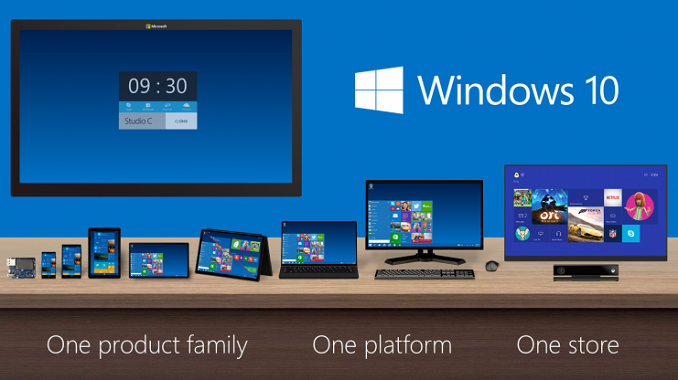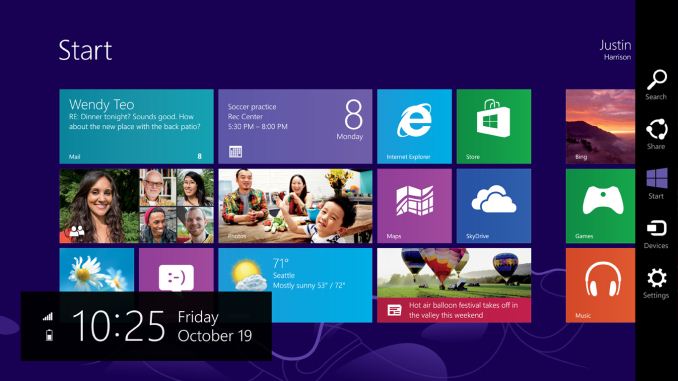Windows 10 Technical Preview First Impressions: The Return Of The Desktop
by Brett Howse on November 13, 2014 8:00 AM EST- Posted in
- Software
- Microsoft
- Windows 10

I’ve said this before, and I will reiterate it now. Windows 8, in general, is not perceived in a positive light. Not necessarily because of the lack of features, or even due to the touch first interface, but because from the start people did not buy into the paradigm. We can argue over why that was, and the specifics are likely different for every individual. But a big part of that was that Windows, which has had a familiar interface since Windows 95, had changed dramatically in look, feel, and general use. The traditional mouse and keyboard PC and notebook is a big part of the Windows user base, and especially at the beginning, Windows 8 did not cater to that crowd. While there were certainly improvements to the desktop, it was not enough to overcome the negative feelings of many users in regards to being productive on their PC. I say this as a fan of Windows 8.1, and I say this despite the positive review from this site. Windows 8 was an OS that worked, but had a steep learning curve that many people did not want to bother learning.
One of the biggest issues facing Windows 8 was just how much people liked Windows 7. Windows 7 was seen as the savior to Vista, and fixed many of its issues. But a lot of the initial problems with Vista were due to a major change in the driver model as well as the security model, which caused a lot of compatibility issues with older programs which expected administrator rights, as well as many hardware devices needed driver updates. With Windows 7, all of those changes were in the rear view mirror, allowing 7 to be a tweak of the overall UI and functionality rather than a rebuild of the OS from the ground up. With Windows 8, the move to touch first caused another dramatic upheaval. This time, rather than incompatible programs and hardware, we got a new Start Screen, a new runtime in WinRT, and a new app model with the Windows Store. For reasons that will never be made clear, the familiar start button was even removed, with the designers relying on hidden functions such as the hot corners to navigate around the OS with a mouse and keyboard. Luckily this change was reversed for Windows 8.1, with the start button returning, even if it still opened the Start Screen. With the Windows 8.1 Update, the system was made much more usable for a mouse and keyboard with the return of the menu bar to close apps, rather than dragging them down off the screen, and several other changes as well which brought the balance back somewhat to cover both touch interfaces as well as the mouse and keyboard.
 Windows 8 at launch in October 2012
Windows 8 at launch in October 2012
With Windows 8, Microsoft tried out an operating system which would work with a single interface across a breadth of hardware, from small form factor tablets, up to 30” monitor desktops. While they certainly succeeded in creating an interface that worked across all of those platforms, it was not ideally suited to any of them. With the tablet mode, the new Start Screen worked very well, and the charms menu and app switcher were fairly easy to use. But many of the settings and programs would be on the desktop, where touch only worked sparingly. Some desktop applications, such as Office, were created with a touch mode to increase the size of the onscreen elements, but overall the experience was subpar. Similarly, on the desktop, the touch interfaces were not ideal, and the hot corners certainly had issues especially on multi-monitor systems.
Windows 10 Technical Preview at launch
But now we come to Windows 10. Windows 10 is ditching the “One Interface to Rule them All” mentality, and moving to a more user friendly model of a single store across all platforms, and multiple interfaces to the same OS depending on the current usage model. We have not seen all of this in practice as of yet in the Technical Preview, but Microsoft has demonstrated their solution to this change in input mode with a feature they are calling Continuum.
The goal is that those that are on a keyboard and mouse based system will have the traditional start menu and desktop, with apps in windows, but if you are on a touch based device, or if you go on a 2-in-1 from keyboard to touch, the system will switch to the Windows 8 style start screen with full screen apps.
One of the keys to having this experience is an app model that allows a developer to target this different user interface paradigms. Microsoft’s solution to this is Universal Apps.











198 Comments
View All Comments
JonnyDough - Friday, January 16, 2015 - link
Microsoft will just force you to switch as they did before. They will drop support and remove updates from the internet so that you can't even patch your old OS to last year's security level.CaedenV - Thursday, November 13, 2014 - link
I have been playing with 10 in a VM on my desktop off and on, and it has been pretty awesome so far. I do wish they would have gone with something more like the WP Start menu and give the option between that and the 'traditional' win7 style menu rather than having tiles endlessly (and annoyingly) sprawl off to the right, but outside of that everything else has run very smoothly.Can't wait for winter break when I will be able to risk installing on my Dell XPS12 to get a feel for the touch and form factor switching capabilities of continuum. That is what is going to make or break this version for mainstream users (who by in large like win8.1). But for business and pro use win10 is already going to be a big step forward compared to 8.
kamm2 - Thursday, November 13, 2014 - link
I know so many people who will not buy Windows 8 computers because of two reasons. The Start screen is one even though I tell people they can install a free app to get the W7 start menu back. The second being that W8 is ugly. From what I've seen this will still be an issue with W10.darthrevan13 - Thursday, November 13, 2014 - link
Flat is the new trend on the web because of everything now need to be responsive to the screen size/window size. Android and iOS became more flatter because of that. If you're hoping for Win 7 style Aero 3D effects then I think you're going to be dissapointed by all OSes, except Linux perhaps, if you have the time to invest customizing your interface.kamm2 - Thursday, November 13, 2014 - link
There is a lot that can be done between the two and flattening an interface does not necessarily mean it has to look ugly. Less appealing to some sure but there are ways to minimize that. iOS 8 and Lollipop does not stir up such a strong dislike. It also doesn't help sales that whenever a W8 device is displayed in an ad there's that loathed start screen staring at you.kyuu - Friday, November 14, 2014 - link
Funny, I think iOS8 is a pretty horrid mishmash of iOS's chiclet-tiles on a grid with modern flat design principles that ends up being pretty ugly. Lollipop simply makes Android look a lot more like Windows 8, really. They certainly did a better job of going flat than Apple did.And I really, really don't get the hate for the start screen's aesthetics. In what way is it worse than iOS and Android's tiles-on-a-grid?
steven75 - Friday, November 14, 2014 - link
It's purely subjective. It just happens to be that you are very much in the minority. Nothing wrong with that.GuardianAngel470 - Saturday, November 15, 2014 - link
Two reasons: 1) Color Clash. Any half-way fashion/home design/color design-conscious person can tell you that some colors should simply not show up next to each other.Windows Phone 7 (the grandfather of ModernUI) didn't have this problem. It had a unified color interface; you picked your color, and all buttons on the start screen were that color. Occasionally some apps would change on you depending on their activity, but the buttons were typically all the color you chose for them.
Windows 8 changed that. Boot up the computer for the first time and you're confronted with half a dozen different pastel colors, many of which clash horribly. It's like looking at a hip woman from the 80's; complete color-induced eyestrain.
2) Massive wasted space. This is an issue I personally have with it, and I'm not sure if anyone else does. Essentially, on a 24+ inch monitor, Windows 8 wastes massive amounts of space. Huge swaths of the Start Screen are just a solid color background. Most of the app buttons are empty space. Apps themselves (back when they were fullscreen by default) had about a 3 to 1 ratio of unused space to relevant info/interface.
Personally, I HATE that. Maybe it's just OCD of me, but I hate wasting space like that. It's physically irritating when it does that. That I couldn't stop it was even worse.
8.1 didn't really help with that either.
inighthawki - Thursday, November 13, 2014 - link
"because of everything now need to be responsive to the screen size/window size"That's funny, I haven't had this issue since... oh wait, never. Windows 7 works great. Flat graphics is a horrible invention of the web because web sites needed to be performant on extremely low end devices (because html, js, and CSS are garbage for performance compared to native code and hardware accelerated graphics), and low bandwidth connections. A desktop OS does not really have these issues. The windows desktop is fully composed using hardware acceleration on a heavily optimized compositor that supports things like occlusion.
kyuu - Friday, November 14, 2014 - link
Except that flat design has nothing to do with performance considerations. This is something that you (and a lot of other people) are essentially making up. Flat design is simply the way design is currently moving -- it's a break from the previous skeumorphism-heavy design ethos. It's a design choice, not a technical consideration. Any performance benefit (from not having to render fake-3D effects and transparencies) is merely tangential.